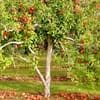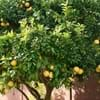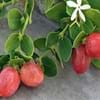Life Span
Perennial
Perennial
Type
Flowering Plants, Fruits, Trees
Broadleaf Evergreen
Origin
Central Asia
China, Japan
Types
Aceymac apple, Bailey Sweet apple, Dabinett apple, Nehou apple
Heavenly Bamboo, Nandina 'Colerno'
Dwarf Nandina 'Compacta'
Dwarf Nandina 'Filamentosa'
Heavenly Bamboo, Nandina 'Harbor Belle'
Heavenly Bamboo, Nandina 'Moon Bay'
Habitat
Hillside
low mountains, Mountain tops, Mountains, Valley
USDA Hardiness Zone
5-8
6-11
AHS Heat Zone
9-1
Not Available
Sunset Zone
A1, A2, A3, 8, 9, 10, 11, 12, 13, 14, 15, 16, 17, 18, 19, 20, 21, 22, 23, 24
21,22
Habit
Oval or Rounded
Clump-Forming
Flower Color
White
Not Available
Flower Color Modifier
Not Available
Bicolor
Fruit Color
Green, Red
Not Available
Leaf Color in Spring
Dark Green
Green, Purple, Copper
Leaf Color in Summer
Green
Green, Purple
Leaf Color in Fall
Brown, Green, Light Yellow
Green, Purple
Leaf Color in Winter
Not Available
Red, Green, Purple
Leaf Shape
Oblong
Acuminate
Plant Season
Spring
Spring, Summer, Fall, Winter
Sunlight
Full Sun, Partial shade
Full Sun, Partial Sun, Partial shade, Full Shade
Growth Rate
Medium
Medium
Type of Soil
Loamy
Loam, Sand
The pH of Soil
Neutral
Acidic, Neutral, Alkaline
Soil Drainage
Well drained
Well drained
Bloom Time
Fall, Summer
Not Available
Tolerances
Drought
Drought
Where to Plant?
Ground
Ground
How to Plant?
Grafting, Seedlings, Transplanting
Seedlings
Plant Maintenance
Medium
Medium
Watering Requirements
Medium
Do not water frequently, Needs less watering
In Summer
Lots of watering
Lots of watering
In Spring
Moderate
Moderate
In Winter
Average Water
Average Water
Soil pH
Neutral
Acidic, Neutral, Alkaline
Soil Type
Loamy
Loam, Sand
Soil Drainage Capacity
Well drained
Well drained
Sun Exposure
Full Sun, Partial shade
Full Sun, Partial Sun, Partial shade, Full Shade
Pruning
Prune when plant is dormant, Remove dead or diseased plant parts
Remove damaged leaves, Remove dead branches, Remove dead leaves
Fertilizers
All-Purpose Liquid Fertilizer
All-Purpose Liquid Fertilizer
Pests and Diseases
Aphids, Canker, Caterpillars, Powdery mildew, Root rot
Red blotch
Plant Tolerance
Drought
Drought
Flower Petal Number
Single
Not Available
Foliage Texture
Medium
Fine
Foliage Sheen
Matte
Glossy
Attracts
Birds
Mealybugs, Whiteflies
Allergy
Mouth itching, Throat itching
Not Available
Aesthetic Uses
Not Used For Aesthetic Purpose
Bonsai, Borders
Beauty Benefits
Not Available
Not Available
Environmental Uses
Air purification
Air purification
Medicinal Uses
Cancer, constipation, Diabetes, Diarrhea, Dysentry, Fever, Heart problems, Tooth ache
Antirheumatic, Antitussive, Astringent
Part of Plant Used
Fruits
Fruits, Leaves
Other Uses
Used As Food, Wood is used for making furniture
Used for making informal hedge
Used As Indoor Plant
No
No
Used As Outdoor Plant
Yes
Yes
Garden Design
Fruit / Fruit Tree, Shade Trees, Showy Tree
Container, Edging, Foundation, Groundcover, Hedges, Mixed Border, Topiary, Bonsai, Espalier
Botanical Name
Malus domestica
NANDINA domestica 'Nana Purpurea'
Common Name
Apple Tree
heavenly bamboo
sacred bamboo
nandina
In Hindi
सेब का वृक्ष
Dwarf Nandina
In German
Apfelbaum
Dwarf Nandina
In French
Pommier
Nandina Dwarf
In Spanish
Manzano
Nandina enana
In Greek
μηλιά
Dwarf Nandina
In Portuguese
Macieira
Nandina do anão
In Polish
jabłoń
Dwarf Nandina
In Latin
Arbore
Dwarf Nandina
Phylum
Magnoliophyta
Tracheophyta
Class
Magnoliopsida
Magnoliopsida
Order
Rosales
Ranunculales
Family
Rosaceae
Berberidaceae
Clade
Angiosperms, Eudicots, Rosids
Angiosperms, Eudicots
Tribe
Not Available
Not Available
Subfamily
Not Available
Not Available
Number of Species
Not Available
Not Available
Season and Care of Apple Tree and Dwarf Nandina
Season and care of Apple Tree and Dwarf Nandina is important to know. While considering everything about Apple Tree and Dwarf Nandina Care, growing season is an essential factor. Apple Tree season is Spring and Dwarf Nandina season is Spring. The type of soil for Apple Tree is Loamy and for Dwarf Nandina is Loam, Sand while the PH of soil for Apple Tree is Neutral and for Dwarf Nandina is Acidic, Neutral, Alkaline.
Apple Tree and Dwarf Nandina Physical Information
Apple Tree and Dwarf Nandina physical information is very important for comparison. Apple Tree height is 25.00 cm and width 20.00 cm whereas Dwarf Nandina height is 30.00 cm and width 60.00 cm. The color specification of Apple Tree and Dwarf Nandina are as follows:
Apple Tree flower color: White
Apple Tree leaf color: Dark Green
Dwarf Nandina flower color: Not Available
- Dwarf Nandina leaf color: Green, Purple and Copper
Care of Apple Tree and Dwarf Nandina
Care of Apple Tree and Dwarf Nandina include pruning, fertilizers, watering etc. Apple Tree pruning is done Prune when plant is dormant and Remove dead or diseased plant parts and Dwarf Nandina pruning is done Remove damaged leaves, Remove dead branches and Remove dead leaves. In summer Apple Tree needs Lots of watering and in winter, it needs Average Water. Whereas, in summer Dwarf Nandina needs Lots of watering and in winter, it needs Average Water.





